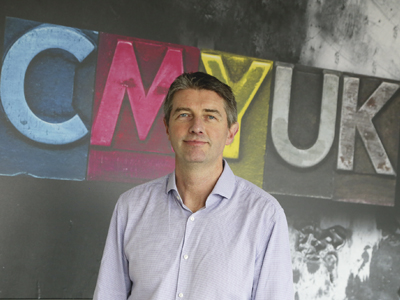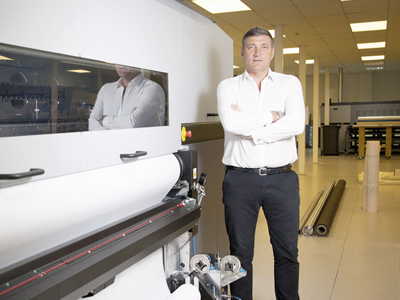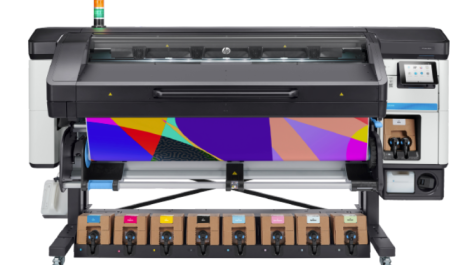Imaginators’ Matt Tydeman: get kit off the books as quickly as possible to speed ROI
Many printers don’t look further than their bank when they need to buy new equipment, but there is a wide range of options available to match the funds to the business requirement. Michael Walker explores the money maze.
The shiny new kit that’s going to revolutionise your business, or maybe just let you keep up with customer demand, is chosen, now you just have to work out how to pay for it. Assuming you’re not so cash rich that you can buy it outright, some kind of financing will be needed. Research on small-to-medium enterprises (SMEs) in the print industry by Close Brothers (presented elsewhere in this issue) suggests that most of them tend to go first to their bank manager, accountant or financial adviser, and that nearly a third wind up taking a straight bank loan to finance their equipment.
But there are alternatives, ranging from hire-purchase arrangements to asset financing to consumables-linked deals that allow repayments to be linked to business volume. Depending on the business’s position and prospects, different types of finance plan might give better flexibility. Digital Printer spoke to various players to see what the options are.
The manufacturer Heidelberg says it works with a range of finance houses and banks, so that its customers can have a choice between existing relationships or whatever is the best deal going at the time. For its digital press line, outright purchase or hire-purchase are the most popular, though it can also arrange consumables bundle financing based around litho sales, where the spend on plates, inks or other pressroom consumables can be used to supplement the capital repayment during busier periods.
‘The write-down period of a digital press is normally three to five years, compared to seven to nine with offset,’ says Heidelberg UK finance director Simon Gamble. He says this reflects the development cycle in the sector and points out the features that have been added to the company’s Versafire toner-based models in the last two years, including banner feed and fifth colour options.
Digital equipment business manager Chris Matthews comments, ‘Finance companies are happy to fund what is a top quality range of digital presses with a good return on investment.’
The end-user
Matt Tydeman, production director at Essex-based wide-format for events specialist Imaginators feels that the relationship with the lender is the most important factor, pointing at the 40-year relationship with HSBC that his company – which was set up by his father – has had.
‘We know the people and understand them, and they understand us. We’ve kept the same relationship manager, and he knows what we would consider,’ he says, adding that the lender’s knowledge of the business allowed the company to invest at times when most would have been refused credit.
Imaginators evolved over the decades from lithography to repro to prepress. The company bought its first wide-format machine nearly 20 years ago and has steadily moved in that direction since, working through a variety of HP Scitex, HP Latex and Durst equipment.
‘We’ve always bought on HP, to get things off the books as fast as possible and speed return on investment,’ explains Mr Tydeman. ‘The technology evolves so quickly, there’s no point financing over a greater length of time, products are superseded. We don’t want to be saying, “we’re still paying for his but would like something else”.’
‘We like to have the asset on the bottom line, it helps the strength of the business. We’re always investing to keep at the front; it’s in our interest to get it off the books ASAP. Once an item is bought and paid for, it still has purpose, it’s a great earner. But you do need to be able to afford to pay in the first place.’
The reseller
CMYKUK has two businesses, one that supplies consumables for wide-format printing, and one, CMYUK Digital, that sells the hardware, principally EFI Vutek, Esko and Mimaki equipment. Finding that it’s difficult to get customers to switch consumables suppliers, the company has introduced a scheme, funded by Paragon Bank Business Finance, under which spend on media can be used to offset the capital repayments on equipment.

Consumables-linked deals can build an “accumulator’ for early settlement, says Jon Price
The idea of consumables deals linked to hardware finance has been around since imagesetter, film and plate days, but group director Jon Price explains, ‘They used to pump the plate prices to allow for this but now we offer the same consumables prices or better.’ He gives an example of a deal where a monthly repayment of £2000 might be half met by CMYUK out of the consumables bill.
‘It’s mostly targeted to the mid-range, £60,000 – £130,000 models, but a high-end deal could be worth £48,000 over four years. It’s better than “nickels and dimes”,’ he says, pointing also to the simplification in supplier arrangements that can come from such a deal.
In terms of ease of gaining finance, Price reports that ‘all lenders see digital print as a quite high risk; a three-year-old printer is not leading edge, though the rate of change in technology has plateaued lately and legacy equipment is seen as still valuable.’
‘The perception of digital print has been tarnished by troubled waters in litho, but every single one of our customers has grown, we’ve only had two bad debts in 14 years.’
If things do turn bad, CMYUK helps find new homes for equipment by refurbishing equipment with outstanding finance, which Mr Price says helps give Paragon a “more pragmatic view” when assessing new applications, adding that CMYUK will ‘help to build the business case for new equipment that will reduce overtime and staff costs’.
The finance specialist
Roger Aust, managing director the print division at Close Brothers Asset Finance was himself a printer once and explains how asset-based lending doesn’t just concern itself with the historic information about a business that a balance-sheet lender would want to see, but ‘brings a new slant to how much we can lend by taking a proactive view of what it brings to the business.’

Roger Aust, Close Brothers
With 30 years’ experience, Mr Aust says he’s seen all the business cycles and his firm is sometimes able to lend when other won’t: ‘When a printer’s had an idea but says “I don’t think I’ll be able to borrow” we can come up with a plan to sensibly and safely make that decision,’ he says.
Noting that lenders’ views of some of the lower-end toner-based digital presses have very low residual values – ‘the kit is worth nothing on day one’ – and so have not been seen as suitable for asset-based lending, Mr Aust explains that Close Brothers would look at the total assets of the business, taking into account litho presses and finishing equipment which are both seen as good bets because of strong and well-defined residual value:
‘There’s safety via equity in other presses; if for example a digital press is £150,000 to £200,000 but there’s £100,000 left in an older £1 million press, that’s security.’
Contradicting the view that print is a risky business for financiers, Mr Aust points out that ‘Printers are a great risk – businesses come and go but people don’t. The work stays, often with the owner, so we like to deal with proprietor-led businesses.’
The finance company
Compass Business Finance is both an intermediary and a finance company in its own right with a major specialisation in print. On the digital side, the company focuses mostly in the smaller end of the market, arranging hire purchase finance for machines that cost under £100,000, with typical fixed-term rentals running for three to five years.
Director Mark Nelson explains that digital presses for general commercial work are viewed as belonging to one of three categories: up to £100,000, which includes mainstream devices from vendors such as Canon, Konica Minolta and Ricoh; £100,000 to around £400,000, which includes the B3 format HP Indigos; and the ‘over £500,000 to £1 million bracket for the bigger HP machines.
‘The first group is easier to fund. Even at £100,000 we can underwrite it the same as a £500,000 litho press that depreciates, it’s a manageable position,’ says Mr Nelson, adding that the second category is similar but the presses have more resale value, though noting that there are not many second hand presses and that repossessions tend to go back to the manufacturer.
The third category he describes as “difficult”, with lenders reticent because of concerns about the ability to re-home a printer from a failed business. ‘Some of these are supported by the manufacturer’s own finance or there’s support from the manufacturer to the finance company; it’s down to the strength of the balance sheet,’ he concludes.
People matter
It’s clear that relationships matter just as much in finance as they do in sales. The lender or broker’s knowledge of both print generally and your business in particular, is invaluable. Lending on low residual value short-lifecycle digital equipment can be supported by the value of conventional presses, including finishing equipment; inkjet devices of any kind, but particularly the more expensive wide-format ones, are seen as a better investment than toner ones and so can attract a wider range of options.
While nobody will explicitly lend on the value of business you haven’t yet got, lenders are open to arguments about how money will be saved through increased productivity. As ever, it pays to shop around.





